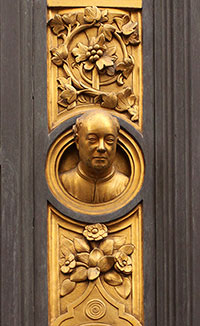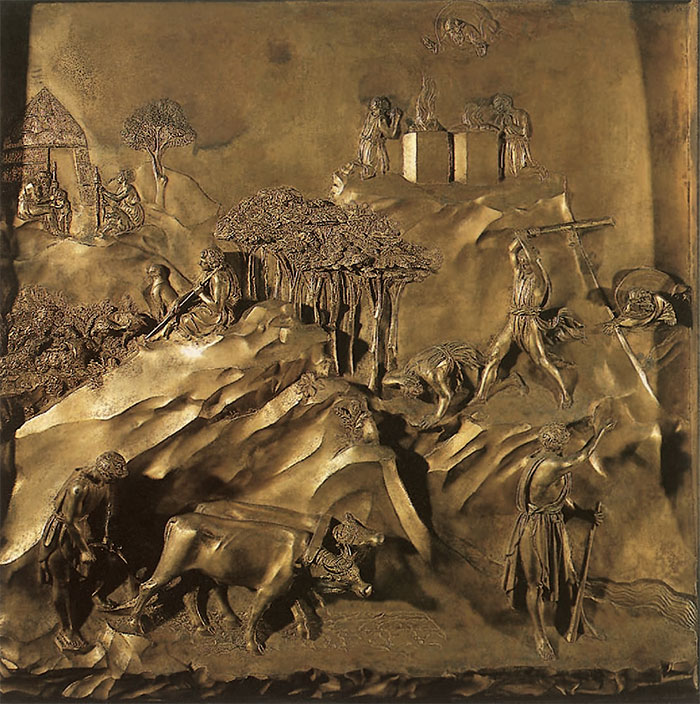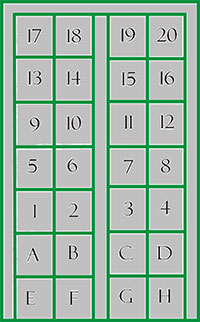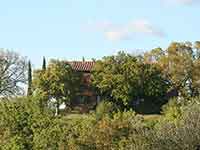| |
|
Life
Early life
Ghiberti was born in Pelago, 20 km from Florence. His father was Bartoluccio Ghiberti, an artist and goldsmith, who trained his son in goldsmithing. He then went to work in the Florence workshop of Bartoluccio de Michele, where Brunelleschi also got his training. When the bubonic plague struck Florence in 1400, Ghiberti emigrated to Rimini, where he assisted in the completion of wall frescoes of the castle of Carlo I Malatesta.
|
Baptistery of San Giovanni
|
|
|
Ghiberti's career was dominated by his two successive commissions for pairs of bronze doors to the Battistero di San Giovanni or Florence Baptistery. They are recognized as a major masterpiece of the Early Renaissance, and were famous and influential from their unveiling. Ghiberti first became famous when as a 23 year-old he won the 1401 competition for the first set of bronze doors; Brunelleschi was the runner up. The original plan was for the doors to depict scenes from the Old Testament, and the trial piece was the sacrifice of Isaac, which survives. However, the plan was changed to depict scenes from the New Testament, instead.
To carry out this commission, he set up a large workshop in which many artists trained, including Donatello, Masolino, Michelozzo, Uccello, and Antonio Pollaiuolo. When his first set of twenty-eight panels was complete, Ghiberti was commissioned to produce a second set for another doorway in the church, this time with scenes from the Old Testament, as originally intended for his first set. Instead of twenty-eight scenes, he produced ten rectangular scenes in a completely different style. They were more naturalistic, with perspective and a greater idealization of the subject. Michelangelo dubbed these scenes the "Gates of Paradise." "The Gates of Paradise" is a major monument of the age of Renaissance humanism.
Earlier doors by Andrea Pisano
As recommended by Giotto, Andrea Pisano was awarded the commission to design the first set of doors in 1329. The south doors were originally installed on the east side, facing the Duomo, and were transferred to their present location in 1452. This took six years, the doors being completed in 1336. These proto-Renaissance doors consist of 28 quatrefoil panels, with the twenty top panels depicting scenes from the life of St. John the Baptist. The eight lower panels depict the eight virtues of hope, faith, charity, humility, fortitude, temperance, justice and prudence. The moulded reliefs in the doorcase were added by Ghiberti in 1452. There is a Latin inscription on top of the door: "Andreas Ugolini Nini de Pisis me fecit A.D. MCCCXXX" (Andrea Pisano made me in 1330).
1401 competition
|
|
 |
 |
|
 |
|
Ghiberti in his account of the competition records the name of seven competitors, all from Tuscany: Filippo Brunelleschi, Lorenzo Ghiberti, Jacopo della Quercia, Simone da Colle, Niccolò d'Arezzo, Niccolò di Pietro Lamberti, and Francesco di Valdambrino. Two of the competition panels have been preserved: one by Lorenzo Ghiberti and the other by Filippo Brunelleschi.
“Today, the panels by Ghiberti and Brunelleschi hang side by side on a wall in the Bargello, originally the Palace of the People, later the city’s prison, now its [Firenze] greatest museum of sculpture.”[10] |
| Ghiberti, Sacrifice of Isaac, 1401-3 |
|
Brunelleschi, Sacrifice of Isaac, 1401-3
|
|
|
In 1401, a competition was announced by the Arte di Calimala (Cloth Importers Guild) to design doors which would eventually be placed on the north side of the baptistry. (The original location for these doors was the east side of the baptistry, but the doors were moved to the north side of the baptistry after Ghiberti completed his second commission, known as the "Gates of Paradise.")[1]
These new doors would serve as a votive offering to celebrate the sparing of Florence from relatively recent scourges such as the Black Death in 1348. Many artists competed for this commission and a jury selected seven semifinalists. These finalists included Ghiberti, Filippo Brunelleschi, Donatello and Jacopo della Quercia,[2] with 23-year old Ghiberti winning the commission. At the time of judging, only Ghiberti and Brunelleschi were finalists, and when the judges could not decide, they were assigned to work together on them. Brunelleschi's pride got in the way, and he went to Rome to study architecture leaving Ghiberti to work on the doors himself. Ghiberti's autobiography, however, claimed that he had won, "without a single dissenting voice." The original designs of The Sacrifice of Isaac by Ghiberti and Brunelleschi are on display in the museum of the Bargello in Florence.
It took Ghiberti 21 years to complete these doors. These gilded bronze doors consist of twenty-eight panels, with twenty panels depicting the life of Christ from the New Testament. The eight lower panels show the four evangelists and the Church Fathers Saint Ambrose, Saint Jerome, Saint Gregory and Saint Augustine. The panels are surrounded by a framework of foliage in the door case and gilded busts of prophets and sibyls at the intersections of the panels. Originally installed on the east side, in place of Pisano's doors, they were later moved to the north side. They are described by the art historian Antonio Paolucci as "the most important event in the history of Florentine art in the first quarter of the 15th century".[3]
The bronze statues over the northern gate depict John the Baptist preaching to a Pharisee and Sadducee. They were sculpted by Francesco Rustici and are superior to any sculpture he did before. Rustici may have been aided in his design by Leonardo da Vinci, who assisted him in the choice of his tools.
Ghiberti was now widely recognized as a celebrity and the top artist in this field. He was showered with commissions, even from the pope. In 1425 he got a second commission, this time for the east doors of the baptistry, on which he and his workshop (including Michelozzo and Benozzo Gozzoli) toiled for 27 years, excelling themselves. The subjects of the designs for the doors were chosen by Leonardo Bruni d'Arezzo, then chancellor of the Republic of Florence.[4] These had ten panels depicting scenes from the Old Testament, and were in turn installed on the east side. The panels are large rectangles and are no longer embedded in the traditional Gothic quatrefoil, as in the previous doors. Ghiberti employed the recently discovered principles of perspective to give depth to his compositions. Each panel depicts more than one episode. In "The Story of Joseph" is portrayed the narrative scheme of Joseph Cast by His Brethren into the Well, Joseph Sold to the Merchants, The merchants delivering Joseph to the pharaoh, Joseph Interpreting the Pharaoh's dream, The Pharaoh Paying him Honour, Jacob Sends His Sons to Egypt and Joseph Recognizes His Brothers and Returns Home. According to Vasari's Lives, this panel was the most difficult and also the most beautiful. The figures are distributed in very low relief in a perspective space (a technique invented by Donatello and called rilievo schiacciato, which literally means "flattened relief".) Ghiberti uses different sculptural techniques, from incised lines to almost free-standing figure sculpture, within the panels, further accentuating the sense of space.
The panels are included in a richly decorated gilt framework of foliage and fruit, many statuettes of prophets and 24 busts. The two central busts are portraits of the artist and of his father, Bartolomeo Ghiberti.
Although the overall quality of the casting is exquisite, some mistakes have been made. For example, in panel 15 of the North Doors (Flagellation) the casting of the second column in the front row has been mistakenly overlaid over an arm, so that one of the flagellators looks trapped in stone, with his hand sticking out of it.[5]
Michelangelo referred to these doors as fit to be the "Gates of Paradise" (It. Porte del Paradiso), and they are still invariably referred to by this name. Giorgio Vasari described them a century later as "undeniably perfect in every way and must rank as the finest masterpiece ever created". Ghiberti himself said they were "the most singular work that I have ever made".
|
|

East doors, or Gates of Paradise, by Lorenzo Ghibertiadise, by Lorenzo Ghiberti

Lorenzo Ghiberti self-portrait - East Doors of Florence Baptistery - c. 1452
|
Gates of Paradise | Lorenzo Ghiberti, Story of Abel and Cain
|
|
|
 |
Lorenzo Ghiberti, Story of Abel and Cain (original panel of the eastern Door of Eden, baptistery of Florence), 1425-1437.
Gilded bronze, 79.5 x 79.5 cm, Museo dell’Opera del Duomo, Florence.
|
|
|
|
1. Adam and Eve
The Adam and Eve Panel documents Ghiberti’s earliest work on the doors and features a splendid depiction of nude figures in a landscape set off by angelic hosts. Ghiberti combined four major episodes from the story of Adam and Eve into this harmonious panel. The creation of Adam, illustrated in the foreground on the far left, shows Adam in a state of semiconsciousness, rising in response to God’s life-giving touch. In the center, as angels look on, God forms Eve from one of Adam’s ribs. The temptation of Adam and Eve by the serpent is shown in the background on the left, while the right side of the panel depicts the couple’s expulsion from Eden. Subtle shifts in the scale of the figures reinforce discrete episodes in the story of the Creation. Ghiberti modulated the scale and degree of projection of the angels to visually separate the four scenes[11].
2. Cain and Abel
3. Noah
4. Abraham
5. Isaac with Esau and Jacob
In the Jacob and Esau Panel, Ghiberti employed a new system of linear perspective to construct the narrative. He arranged the episodes of the story around a vanishing point framed by the central arch of a Renaissance loggia. This panel, with its nearly three-dimensional foreground figures, masterful use of scientific perspective, and impressive architecture, shows that the artist was at the vanguard of Florentine illusionism and storytelling. In the panel, Jacob obtains the birthright of his elder brother, Esau, and the blessing of their father, Isaac, thus becoming the founder of the Israelites. Rebekah is shown giving birth to the twins beneath the arcade on the far left. On the rooftop in the upper right, Ghiberti depicted her receiving the prophecy of her sons’ future conflict.
Framed inside the central arch, Esau sells his rights as firstborn to Jacob, who offers his hungry brother a bowl of soup in exchange. In the front center of the panel, Isaac sends Esau hunting, and, in the right foreground, Jacob kneels before the blind Isaac, who, feeling a hairy goatskin on Jacob’s back, believes him to be Esau and mistakenly gives him the blessing due to the eldest son.[11]
6. Joseph
7. Moses
8. Joshua
9. David
In the David Panel, Ghiberti illustrated the young David’s victory over the giant Goliath. David is shown in the foreground cutting off the giant’s head after knocking him down with a stone. Above this episode, King Saul—clearly labeled and elevated over the fighting Israelites and Philistines—leads his troops in a rout of the enemy. A cleft in the mountains beyond reveals David and his followers carrying Goliath’s head in triumph toward Jerusalem.[11]
10. Solomon and the Queen of Sheba.
South and north doors
|
|

East doors, the Gates of Paradise (Lorenzo Ghiberti) : 1. Adam and Eve 2. Cain and Abel 3. Noah 4. Abraham 5. Isaac with Esau and Jacob 6. Joseph 7. Moses 8. Joshua 9. David 10. Solomon and the Queen of Sheba.
At the centre of the door at left is the self-portrait of Ghiberti. |
 |
|

|
|
|
South doors (Andrea Pisano) 1. The angel announces to Zachariah. 2. Zachariah is struck mute 3. Visitation 4. Birth of the Baptist. 5. Zachariah writes the boy's name. 6. St John as boy in the desert. 7. He preaches to the Pharisees. 8. He announces Christ. 9. Baptism of his disciples. 10. Baptism of Jesus. 11. St John reprimands Herod Antipas. 12. Incarceration of St. John. 13. The disciples visit St. John. 14. The disciples visit Jesus. 15. Dance of Salome. 16. Decapitation of St. John. 17. Presentation of St John's head to Herod Antipas. 18. Salome takes the head to Herodias 19. Transport of the body of St. John. 20. Burial. A. Hope B. Faith C. Charity D. Humility E. Fortitude F. Temperance G. Justice H. Prudence
|
|
North doors (Lorenzo Ghiberti): 1. Annunciation. 2. Nativity. 3. Adoration of the magi. 4. Dispute with the doctors. 5. Baptism of Christ. 6. Temptation of Christ 7. Chasing the merchants from the Temple. 8. Jesus walking on water and saving Peter. 9. Transfiguration. 10. Resurrection of Lazarus. 11. Entry of Jesus in Jerusalem. 12. Last Supper. 13. Agony in the Garden. 14. Christ captured. 15. Flagellation. 16. Jesus before Pilate. 17. Ascent to Calvary. 18. Crucifixion. 19. Resurrection. 20. Pentecost. A. St. John Evangelist. B. St. Matthew C. St. Luke D. St. Mark E. St. Ambrose F. St. Jerome G. St. Gregory H. St. Augustine. |
|
|
Other works
|
| |
He was commissioned to execute monumental gilded bronze statues to be placed within select niches of the Orsanmichele in Florence, one of Saint John the Baptist for the Arte di Calimala (Wool Merchants' Guild) and one of St. Matthew for the Arte di Cambio (Bankers' Guild). Finally, he also produced a bronze figure of St. Stephen for the Arte della Lana (Wool Manufacturers' Guild).
He was also a collector of classical artifacts and a historian. He was actively involved in the spreading of humanist ideas. His unfinished Commentarii are a valuable source of information about Renaissance art and contain an autobiography, the first of an artist. This work was a major source for Vasari's Vite. Ghiberti died in Florence at the age of seventy-seven.[6]
Ghiberti's “Commentario” includes the earliest surviving autobiography of an artist. He discusses the development of art from the time of Cimabue through to his own work. In describing his second bronze portal for the Florence Baptistry, he states: "In this work I sought to imitate nature as closely as possible, both in proportions and in perspective... the buildings appear as seen by the eye of one who gazes on them from a distance."[6b]
Paolo Uccello, who was commonly regarded as the first great master of perspective, worked in Ghiberti's workshop for several years, so it became difficult to determine the extent to which Uccello's innovations in perspective were due to Ghiberti's instruction. Donatello, known for one of the first examples of central-point perspective in sculpture, also worked briefly in Ghiberti's workshop. It was also about this time that Paolo began his lifelong friendship with Donatello. In about 1413 one of Ghiberti's contemporaries, Filippo Brunelleschi, demonstrated the geometrical method of perspective used today by artists, by painting the outlines of various Florentine buildings onto a mirror. When the building's outline was continued, he noticed that all of the lines converged on the horizon line.
Recent scholarship indicates that in his work on perspective, Ghiberti was influenced by the Arab polymath Alhazen who had written about the optical basis of perspective in the early 11th century. His Book of Optics was translated into Italian in the 14th century as Deli Aspecti,[7] and was quoted at length in Ghiberti's “Commentario terzo.” Author A. Mark Smith suggests that, through Ghiberti, Alhazen's Book of Optics "may well have been central to the development of artificial perspective in early Renaissance Italian painting."[8] |
| |
|
|
| |
|
|
| |
|
|
| |
|
|
|
|
| |
|
Florence, view on and the Baptistry |
|
|
| [1] See Laurie Schneider Adams, Italian Renaissance Art, (Boulder, Colorado: Westview Press, 2001), 60. Actually, at the time of the 1401 competition the Florence baptistry needed two portals to be decorated. The aim of the 1401-02 competition was to begin work on this project. See also Monica Bowen, "Ghiberti's North Doors," fromAlberti's Window, July 24, 2010.
[2] The Premier Artists of the Italian Low Renaissance
[3] Antonio Paolucci (1996), "The Origins of Renaissance Art: The Baptistery Doors, Florence" 176 pages; Publisher: George Braziller; ISBN 0807614130
[4] Scott, Leader (1882). "Chapter III. Baptistery Doors". Ghiberti and Donatello. London: Sampson Low, Marston, Searle, & Rivington. p. 65.
[5] Julian Bell (2007). Mirror of the World: A New History of Art (1st paperback ed.). Thames & Hudson. p. 161. ISBN 978-0-500-28754-5. "It is noticeable nonetheless that the casting of one column has been mistakenly overlaid over a flagellator's arm, as it were trapping his hand."
[6] Artnet artist biographies retrieved January 25, 2010
[6b] Two written accounts of the competitionfor the doors have also survived. Lorenzo Ghiberti includes his version in his Commentarii, while the biography of Brunelleschi written possibly by Antonio Manetti between 1471 and 1497 presents an alternative account.
Excerpt from Ghiberti's Commentarii: 'In my youth in the year of Christ 1400, because of the corrupt air in Florence and the bad state of the country, I left that city with an excellent painter whom Signor Malatesta of Pesaro had summoned. He had had a room made which was painted by us with great care. My mind was in a large part turned to painting because of the work the prince promised us, and also the companion with whom I was continually showed me the honor and benefit we would acquire. However, at this time my friends wrote me that the governors of the church of S. Giovanni Battista were sending for skilled masters whom they wished to see compete. From all countries of Italy a great many skilled masters came in order to take part in this trial and contest. I asked permission of the prince and my companion to leave. The prince, hearing the reason, immediately gave me permission to go. Together with the other sculptors I appeared before the Operai of that church [Baptistry of S. Giovanni]. To each was given four tables of bronze. As the trial piece the Operai and the governors of the church wanted each artist to make one scene for the door. The story they chose was the Sacrifice of Isaac and each contestant was to make the same story. The trial pieces were to be executed in one year, and he who won had to be given the victory. These were the contestants: Filippo di Ser Brunellesco, Symone da Colle, Nicholò d'Areço, Jacopo della Quercia da Siena, Francesco di Valdombrina, Nicholò Lamberti. We six were to take part in the contest, which was to be a demonstration of the art of sculpture. To me was conceded the palm of victory by all the experts and by all those who had competed with me. To me the honor was conceded universally and with no exception. To all it seemed that I had at that time surpassed the others without exception, as was recognized by a great council and an investigation of learned men. The Operai of the governing board wanted the judgment of these men written by their own hands. They were men highly skilled from the painters and sculptors of gold, silver, and marble. There were thirty-four judges from the city and the other surrounding countries. The testimonial of the victory was given in my favor by all, the consuls, the Operai , and the entire merchant's guild which has charge of the church of S. Giovanni....
[7] Falco, Charles M. (12–15 February 2007), Ibn al-Haytham and the Origins of Modern Image Analysis, International Conference on Information Sciences, Signal Processing and its Applications
[8] A. Mark Smith (2001), "The Latin Source of the Fourteenth-Century Italian Translation of Alhacen's De aspectibus (Vat. Lat. 4595)", Arabic Sciences and Philosophy: A Historical Journal (Cambridge University Press) 11: 27–43 [28]
[9] "Brunelleschi & Ghiberti, The Sacrifice of Isaac". Smarthistory at Khan Academy. Retrieved January 6, 2013.
[10] Walker, Paul Robert. The Feud That Sparked the Renaissance, p. 22. Ne
w York: HaperCollins, 2002.
Two written accounts of the competition have also survived. Lorenzo Ghiberti includes his version in his Commentarii, while the biography of Brunelleschi written possibly by Antonio Manetti between 1471 and 1497 presents an alternative account. See more on .
[11] [Source: www.artic.edu/aic/exhibitions]During the Renaissance, bronze was far more costly than marble, and it posed significant technical difficulties in an age before industrial casting. Ghiberti created the Gates of Paradise using a technique known as lost-wax casting. After making drawings and sketch models in clay or wax, he prepared full-scale, detailed wax representations of every component of the reliefs. (Some scientists and scholars believe that he modeled his reliefs directly in wax; others propose that he made an initial model in another material and then made an indirect wax cast.) When Ghiberti and his assistants finished a model, they added wax rods in branching patterns to its back. The entire relief was then covered in a fire-resistant material like clay and heated until the wax melted out, leaving a hollow mold. The spaces that had been occupied by the rods served as sprues (channels) through which bronze reached the surface of the relief. The sprues were cut away from the reliefs after casting, but their remains are still visible on the back of each panel.
|
|

Podere Santa Pia is an old farm that has been renovated into a perfect holiday house located 350 meters above sea level in a panoramic position. The location of Podere Santa Pia is unique and the landscape a once-in-a-life sight.
The central location of the holiday home allows you to visit the nearby beautiful villages Montalcino, Sant'Antimo, Pienza, S. Quirico d'Orcia and in the south Saturnia and Sorano - known for its beautiful Sasso Leopoldo. And the sea is 38km away in Marina di Grosseto.
Brunello di Montalcino, perhaps Italy's best-known wine region, makes a good starting place for a wine tasting tour. Castello Banfi is within easy reach and Montalcino is only 28 kms away.
The hidden secrets of southern Tuscany | Tuscan farmhouses | Podere Santa Pia
|
 |
|
| |
|
|

. |
|
|
Podere Santa Pia |
|
Podere Santa Pia, garden view, December |
|
Bagni San Filippo |
| |
|
|
|
|
|
|
![]()
![]()
![]()
![]()
![]()














